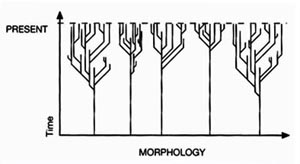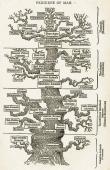Do many scientists think that the fossil record supports a polyphyletic view of the history of life?
Summary of problems with claim: There is no evidence to support this assertion; moreover, Explore Evolution misunderstands the terminology.
Full discussion:
Diagram 1:12 shows three models of evolution.
In the first, we see a diagram labeled "the neo-Darwinist picture." This diagram shows smooth transitions between branches.
In the second, this diagram is labeled "punctuated equilibrium," and shows a similar structure to the first diagram, with the exception of the branches being sharp and angular. The idea with this diagram is that transitions occur more rapidly than in the first diagram.
The third diagram is labeled "a polyphyletic view," and shows five separate trees all beginning at the same time. Curiously, the transitions between branches seem to be a mixture of the first and second diagrams.
 A Orchard?: Explore Evolution's inaccurate diagram of polyphyletic relationships
A Orchard?: Explore Evolution's inaccurate diagram of polyphyletic relationships
In the sense that they mean it, a polyphyletic model involves several different trees of life, each starting separately (Explore Evolution, p. 10). This is not what scientists mean when they use the term polyphyletic.
From Campbell (p. 471):
A taxon is said to be monophyletic is a single ancestor gave rise to all species in that taxon and to no species placed in any other taxon. A taxon is polyphyletic if its members are derived from two or more ancestral forms not common to all members. A paraphyletic taxon excludes species that share a common ancestor that gave rise to the species included in the taxon.Campbell, Biology, 4th edition, 1996
Therefore, in this diagram, A = monophyletic, B = paraphyletic , and C = polyphyletic
 Trees of Life:: Monophyletic (A), paraphyletic (B), and polyphyletic (C) relationships
Trees of Life:: Monophyletic (A), paraphyletic (B), and polyphyletic (C) relationships
This is a completely different sense than the way Explore Evolution uses these terms. Note that in the case of C, polyphyletic, the splitting branches still originate from a single common ancestor.
On page 19 of Explore Evolution, three cartoons show Charles Darwin drawing a "Tree of Life."
Explore Evolution asks:
His famous tree analogy was Darwin s way of interpreting (or making sense of) the fossil data. But what sense did he make of it?Explore Evolution, p. 19
Explore Evolution answers its own question, saying that Darwin thought "younger fossil forms arose from older ones," and
Every creature on Earth must ultimately be linked to a single common ancestor in the distant past: the root or trunk of the Tree Life.Explore Evolution, p. 19
 Haeckel's Tree of Life: Image from WikiCommons
Haeckel's Tree of Life: Image from WikiCommons
Although he discussed the concept, Darwin did not actually make any Tree of Life diagram in Origin of Species. Showing Darwin, even in cartoon form, drawing such a tree is a distortion of Darwin's writings.
Ernst Haeckel drew the earliest phylogenetic trees. The modern term for phylogenetic trees is cladograms. Cladograms are a very useful way to represent the phylogenetic tree of life and to show the common descent of animals.
Explore Evolution asserts:
In the overwhelming majority of cases, Common Descent does not match the evidence of the fossil record.Explore Evolution, p. 27
This is an absurd claim, completely at odds with the scholarship of 150 years of paleontological research. Explore Evolution does not have a citation to back up this claim because no such reference exists outside creationist works.
